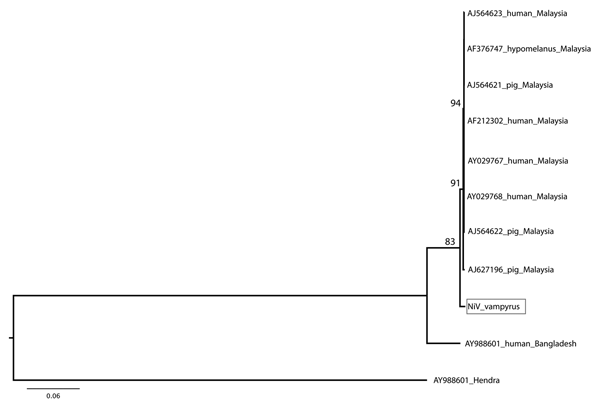Characterization of Nipah Virus from Naturally Infected Pteropus vampyrus Bats, Malaysia
Sohayati A. Rahman

, Sharifah S. Hassan, Kevin J. Olival, Maizan Mohamed, Li-Yen Chang, Latiffah Hassan, Norsharina M. Saad, Syamsiah A. Shohaimi, Zaini C. Mamat, M.S. Naim, Jonathan H. Epstein, Arshad S. Suri, Hume E. Field, Peter Daszak, and the Henipavirus Ecology Research Group
Author affiliations: Author affiliations: Veterinary Research Institute, Ipoh, Malaysia (S.A. Rahman, S.A. Shohaimi, Z.C. Mamat, M.S. Naim); Monash University, Selangor, Malaysia (S.S. Hassan); EcoHealth Alliance, New York, New York, USA (K.J. Olival, J.H. Epstein, P. Daszak); University of Science Malaysia, Kelantan, Malaysia (M. Mohamed); University of Malaya, Kuala Lumpur, Malaysia (L.-Y. Chang); University Putra Malaysia, Serdang, Selangor (L. Hassan, A.S. Suri); Ministry of Science, Technology and Innovation, Putrajaya, Malaysia (N.M. Saad); Queensland Primary Industries and Fisheries, Moorooka, Queensland, Australia (H.E. Field)
Main Article
Figure 1

Figure 1. Phylogenetic position of Nipah virus (NiV) isolate from Pteropus vampyrus bats (box) in combined analysis of nucleocapsid, phosphoprotein, matrix, fusion, and attachment gene open reading frames (8.3 kb). Maximum likelihood tree, general time reversible + Γ model, 1,000 bootstrap replicates. NiV P. vampyrus is distinct but forms a clade with other NiV sequences from Malaysia, and the isolate from Bangladesh is more distantly related and basal to this group. GenBank accession numbers are shown for all comparison isolates; the polymerase gene is missing for AF376747 and thus that isolate is excluded from analysis. Scale bar indicates nucleotide substitutions per site.
Main Article
Page created: August 28, 2011
Page updated: August 28, 2011
Page reviewed: August 28, 2011
The conclusions, findings, and opinions expressed by authors contributing to this journal do not necessarily reflect the official position of the U.S. Department of Health and Human Services, the Public Health Service, the Centers for Disease Control and Prevention, or the authors' affiliated institutions. Use of trade names is for identification only and does not imply endorsement by any of the groups named above.
